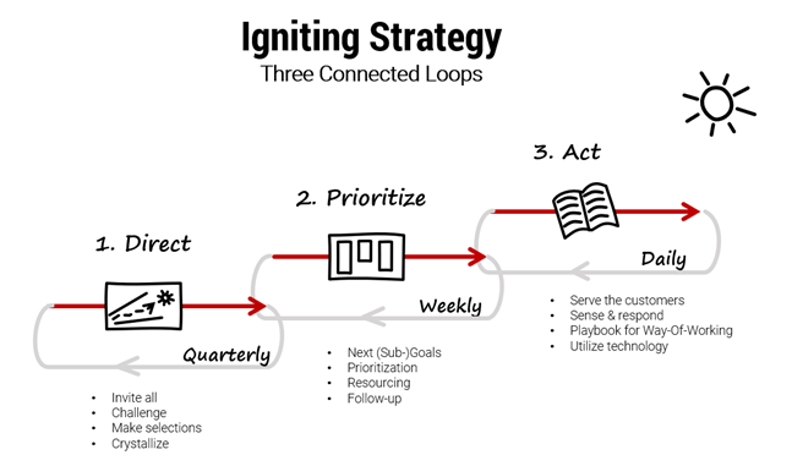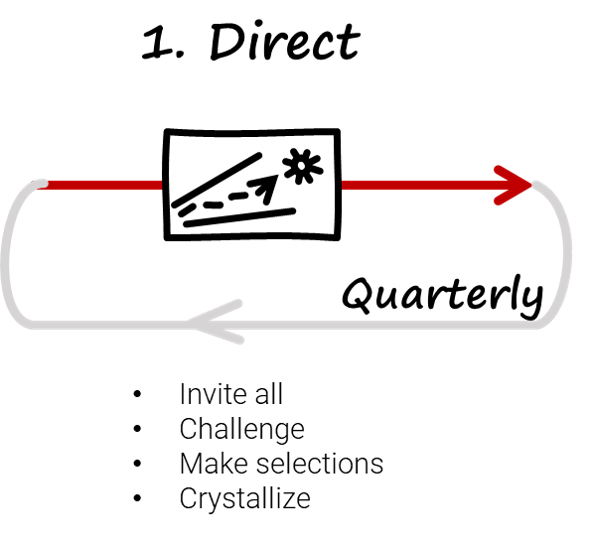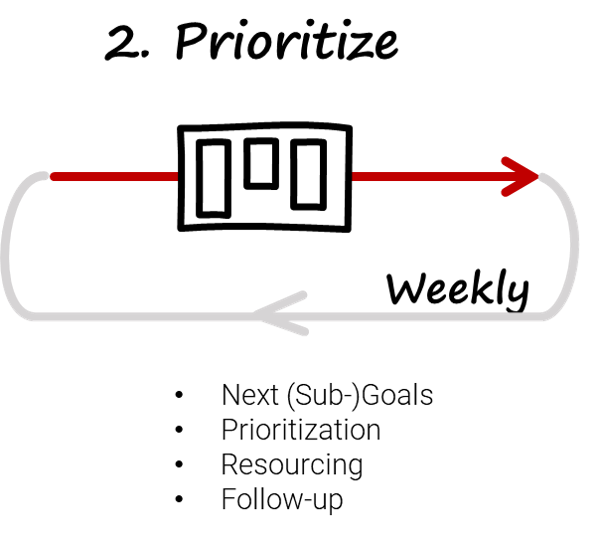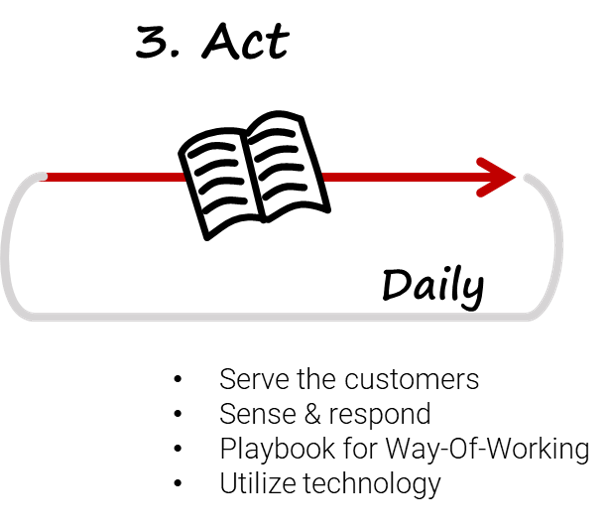
Management Worries About Strategy Creation — 1.10
Markus Westerlund
Share this blog
Today I will tell you about a great technique, which can help a customer understand that they need help to solve a specific problem. As an example, I use my own field, strategy creation. This blog is not about solutions to the management’s problems, I’m focusing on worries.
The point is that I use the word worry. I speak about management’s worries about strategy creation. I’ll give examples about focusing on worries and explain how you too can use this technique.
All leaders come face to face with worries at some point.
How to create a good strategy?

A CEO understands that a direction needs to be decided. After that, they begin to wonder how it will be handled this time. They might end up with many questions! With the help of my colleagues, we have collected these worries for several years. Now I will show you tens of worries, emphasizing the word worry.
Difference between worry and need. The customer might have a need, which is the solution to their worry. If my worry is thirst, I need a beer. Beer, in this case, is the solution to thirst. However, if I ask the customer what they need, I’m basically delegating the competence to answer to a person who is not a professional in our field. So, one shouldn’t ask the customer for their needs. Instead, one should listen to their worries and take responsibility for expressing the solution to them.
The world’s best method in sales is to make the customer’s worries visible to them. Because we have met many customers in the same situation, we can actually articulate the customer’s worries better than themselves. In this situation, the customer understands much better that they indeed should buy from this person, because they won’t be able to find solutions to all their worries alone.

There are a lot of typical upper-level questions. How can I get my company to grow and succeed better than ever? This question can be broken down into a big bundle of worries.
What about customers? Think: What questions have your customers asked lately? What do they truly want from you? Take notice, that a customer doesn’t know all the new tricks in the business, so they might ask for the old stuff! This is when you should know how to explain that yes, things can be done like that, but that they might be interested in your newest solution.
What bugs us in our work? How can we work better with a new strategy? What happens on the market? What are the big trends that influence our customers as well? How many people should one involve in the process? How do I involve everyone? How to challenge one’s own way of thinking? What is the big focus that we should have in the next phase? How to simplify things? Let’s break these down.
Growth? What bugs us? Trends?

How to grow? How to understand what to invest in? How to grow, what are our assumptions about the future?
What’s bugging us? What isn’t truly working? How to fix it? Where is all of the organization’s time spent on? Why don’t we get more done for the customer?
Trends? What’s happening on the market? Do we know how to analyze? Which trends influence both us and the customers? What is the competition doing, how do we respond?
These types of questions may arise. Let’s look at questions about involving people.
How to involve people on a large scale?

Involving? How to involve people? Should it be done on a larger scale? If I involve a group to come and join in, are grassroot views at all relevant on a strategic level? How do we avoid the strategy not being diluted when many are included? How do we avoid consensus thinking and a blunt spearhead?
Duration? If I involve many people, does the process take too long? Does it take too much time? – No, when you use technology! That’s the whole point.
Expensive? Is it expensive to involve people on a larger scale? – It’s expensive if you don’t involve them! Does the CEO have the right to decide? – In my opinion, yes. The CEO is the one that makes the ultimate decision. Of course, a good leader listens to others.
Our Purpose for our customers?

Our purpose. The upper-level worry is the purpose for our customers. It is something that should be crystallized in the strategy process. And especially from the customer’s perspective! Not selfishly so, as to how we earn more. If we help the customer really well, they will also pay us more. We produce so much more value to them. It creates a win-win situation, which is a fine thing in every way.
Why do we exist? What is our vision? Are we only thinking about ourselves and not enough about the customers? Are we only thinking about our own numbers, growth, and sealing the deal?
What does the customer want? Do we understand what the customer truly wants? Do we understand the reason they are working with us? What the customer wants can be a completely different thing compared to what they truly need. Maybe they aren’t even able to express it themselves.
Meaningfulness? What is the core reason why people work here? What excites our group? What makes this work meaningful to them? The answer to all of these questions is our purpose. The power of words is incredible. Words are the most powerful weapon, even today. If you can crystallize the Purpose to a few words, it has immense meaning to how you are able to get people to join the process.

All in a bubble? One should always question, whether we are proceeding on the optimal road? In Stradigo, we have begun using the bubble metaphor, which my colleague Veli-Matti came up with.
Is the entire management in the same bubble? Do we repeat the same mantras? Are we able to question our actions ourselves? We might have certain mantras that are outdated. Which beliefs about growth are no longer good?
No one knows anything about the future, every crystal ball has been sold out. We, however, need beliefs about the future, and that is what our strategy is based upon. But, have they ever been written down? Are some of them already outdated?
Do we dare to challenge? It can be a touchy thing if someone no longer believes in our holy mantras.
Do we lose face? This, my friend, is a tough spot. In a situation like this, a third party might be of interest, because they can ask these questions without having to play the game of organizations.
How to challenge in a positive way without annoying people? People might lose their temper if someone begins to challenge their core beliefs. With success, we have believed in them for years.
How do we work faster? Can we do things ten times faster? Impossible, many say. But is it, if you use new technology?
How do we create a positive mood after we have challenged and ripped things apart?
Digital technology? What about digital technology? Are we doing things the old way? Do we even know what’s possible? In B2B sales it’s already possible to speak with thousands every week! Instead of meeting five people every week and making a huge amount of missed calls just to reach a customer, can digital technology enable live speaking to thousands every week? It’s the power of express videos.
Focus

What to focus on? What should be focused on with enough precision to create growth?
Do we have the guts? Do we have the guts to prioritize? Is focusing actually a distress to us because it narrows the playing field?
Reacting. How do people react, if we prioritize differently? They might think that it’s the same as killing their “baby” if the company goes in a different direction. “What happens to us in this rampage?” Very often one doesn’t want to annoy and frighten people, and a good decision is left unmade in the lack of courage.
Concretizing. How to concretize focus to an implementing level? It’s nice to talk about high-cloud stuff, but how could one get long enough legs so that concretizing know-how would exist? Is the new suggestion for a focus even compatible with our culture? Is our culture rejecting it? Do we have the resources and the capability?
These are questions, which pop up in the management’s head as they begin planning how the strategy is done.
Simplify

How do we get a simple enough strategy? If the result is a thick bunch of PowerPoint slides, no one will remember them. The strategy won’t implement, it’s totally useless.
Do folks know how to concretize the strategy? Have we helped? How does the group even remember what the strategy is?
As I write this, I am on my 95th Strategy 1Pager. We include the focus areas and the big goals, and of course our purpose, the breakthrough goals. The way we proceed towards the sun. The benefit of a one-page strategy is that it can be easily updated.
Think, can you crystallize your customer’s worries. In the end, they are all questions. However, worry is a great word, because it involves feelings. It’s not just a fact, it’s also true! 😎 Listen to the customers because they tell you their worries in every sentence.
When every worry within a situation is combined and presented on one page, the strategy is ignited! People notice that they haven’t realized the number of worries they have. They must all be answered with a solution and we are able to do it. Yeah!
Ignite your strategy! Read more.🔥
Recent Posts
Stradigo
Stradigo is a brand owned by Rdigo Oy (Business-ID: 2120844-1).
Learn more from our Imprint.
Rdigo Oy is registered in Finland as a Limited company. We are a strategy consultancy located in the Helsinki capital region.
We’ve been in business since 2007. The company name comes from the latin word Redigo, meaning both ‘I shape’ & ‘I renew’.
Stradigo combines the word strategy with Rdigo.

















 — 1.14
— 1.14


































































